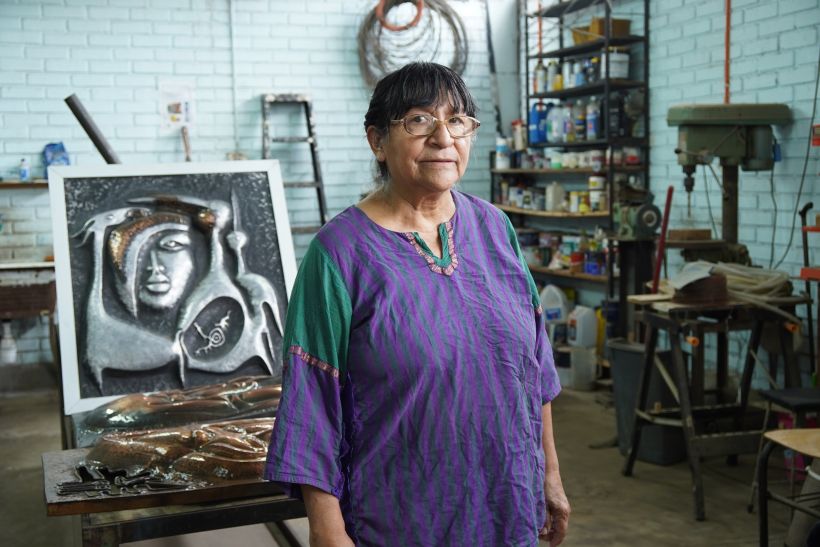
Biography
Since childhood, Edith showed strong drawing skills. The images of flora and fauna of her home town are a constant in her collective memory as a source of creativity. She studied at School No. 4 of Codpa up to 3rd grade. In 1960, she settled down in Arica in order to continue her studies at Lincoyan School. Then, she continued at Colegio Medio de Niñas, Instituto Comercial, and finally, the University of Chile in Arica city. There she obtained the Degree of Artificer in Enamel on Metals.
In 1972, Nora Puchi, her professor of enamel on metals at School of Applied Arts at University of Chile, significantly influenced her approach to the arts of fire. At the end of the year, the artist met the master Pedro Bascuñan who came from the School of Bellas Artes at University of Chile in Santiago city. He definitely led her to the artistic expression on metals by means of embossing and chiseling; a volumetric technique that she would develop to the maximum in her numerous works.
After graduating in 1977, she began teaching at the same University that trained her. She gave classes of graphic expression, drawing, embossing and chiseling, and enamel on copper for the Degree of Artificer and Pedagogy in Plastic Arts.
In 1980 she received a scholarship from the Organization of American States (OAS) and the Inter-American Traditional Art Center (CIDAP) in order to participate in the First Meeting of Artificers in Cuenca, Ecuador. Afterwards, she completed a teaching training in the specialization of lost wax casting, at the Faculty of Arts of the University of Chile, in Santiago, with the Master Byron Boyd. She obtained the degree of Technical Professional Education in the faculty of education at Universidad de Tarapacá, Arica and studied for a doctorate in Sculpture and Photography at the University of the Basque Country in Bilbao, Spain.
In 1993, she won the first prize in the National Contest of Artistic Creation in Copper, organized by the University of Chile in Santiago, with the work called Solrachtide II, which gave her the opportunity to measure herself with her peers.
Her artistic works have visited several national and international galleries and museums in different towns and cities, such as Codpa, Arica, Iquique, Calama, Antofagasta, Santiago, Viña del Mar, Valparaíso and Santiago (Chile); Tacna and Puno (Peru); Cuenca and Quito (Ecuador); Santa Cruz de la Sierra and Cochabamba (Bolivia); Sao Paulo (Brazil); Florida (United States); Ontario (Canada); Bressuire (France); Bilbao, Arrigorriaga, Las Arenas and Guetaria (Spain).
In addition to the production of artistic works, Edith Soza has been teaching and exhibiting in various art galleries and directed the Metal Workshop of the Arts Center at the University of Tarapacá, Arica since 1977 so far. Currently, she teaches goldsmithing/silversmithing and artistic jewelry to students and the community.
Edith’s artistic creation has to do with the exaltation of the culture of her Quechua-Aymara people, their roots, and their connection with nature, through several techniques of the plastic arts such as oil, pastel, metals, enamels, goldsmithing/silversmithing and sculpture on metal and wood.
ART IS THE EXPRESSION OF THE SOUL
Art is the artists’ expression of the soul, it is the way a person has to show the world their greatest ambitions, aspirations, fears, jubilations, and any other situation they wish to express, through the use of plastic, sound, or other disciplines.
Art is the means in which the artist transmits to the spectator their perspective of empirical reality, knowledge, and sensitivity; it is the demonstration of the activities of the intellect that come to fruition under two parameters: technique and concept.
The importance that the acquired influences in the field of formal representation and emotional stimuli have in the artists’ labor consist in that they are the starting point for the growth of your own plastic language. Likewise, chance is formed as an incentive, an engine for creation, stimulating and motivator for the transgression of what is established, and the moving force for motivation in Art.
Every artistic work or activity in the field of plastic arts carries implicitly an investigation labor throughout the making process, which is established by the talent, the experience, and the determination of the author. Therefore, each work is composed of a technical, aesthetic, and cultural aspect.
The author proposes a communication problem, paired with a reflection that externalizes from its inner self and most intimate emotions, to set itself into a proposal that projects and engages the audience from a time and space perspective.
In the process of transformation of the real world to our creative world, it gradually produces changes in ourselves as artists, just as our creations, in turn, have an influence in the social context that they are part of. In the same way, the personal and professional relation with other artists, whose art language is shared as a means of aesthetic expression, influence the creator and its work.
